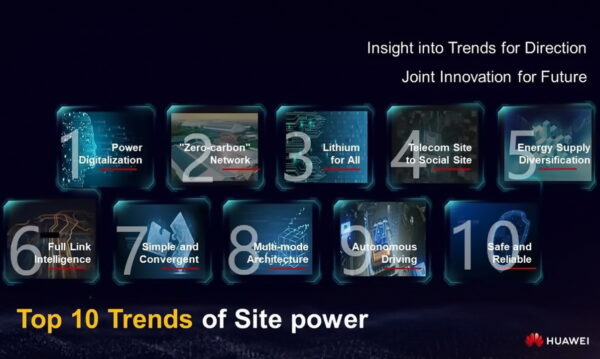As emerging technologies such as 5G, Internet of Things (IoT), cloud computing, and artificial intelligence (AI) are rapidly commercialized, the digital transformation in various industries is getting prospering. The epidemic and carbon neutrality goals further accelerate the transformation towards a smart society. What does it mean to the site power? What will happen if the energy technologies are combined with the power electronics technologies and digital technologies?
To answer these questions, Peng Jianhua, President of Huawei Site Power Facility Domain, together with industry guests, discussed the technology and industry trends and predicted the ten trends in the site power domain. The ten trends are released to provide clues of development directions and innovation for the industry and help build a better future.
Trend 1: Power Digitalization
The full power link from power generation, conversion, storage, to use will be digitalized. The entire energy network will change from the traditional watt flow to watt+bit collaboration, driving the digital transformation of site power from points, chains, and networks with the concept of Bit Manage Watt. The convergence of digital technologies and energy technologies will make energy networks visible, manageable, controllable, and optimizable.
To this end, Huawei explores a three-layer energy target network from the components, site, to network to help customers build a simple, intelligent, green, and reliable energy target network and meet the new energy development requirements in the future.

Trend 2: “Zero-Carbon” Network
Green and sustainable development is a global campaign. Clean energy application and energy saving have become the mainstream around the world. In the future, the full link of power generation, load consumption, and power conversion and storage will be green, efficient, and energy-saving. From the top-level network planning and design, construction and capacity expansion, to the reconstruction and optimization, digital O&M and energy efficiency management, and zero-carbon evaluation, a zero-carbon network will be realized through the integration of power electronics, digital, and AI technologies. The rapid development of core technologies, high-efficiency technologies, and digital technologies also makes zero-carbon networks possible. Energy-related OPEX for carrier networks will not increase after adding 5G, greatly reducing CAPEX. Carbon emissions of networks will be cleared through simplified network construction, intelligent O&M, and full-lifecycle management of energy networks.
In Green Island, Greece, Huawei helps a carrier reduce carbon emissions by 10 tons per site per year by intelligent solar access. In Pakistan, Huawei uses advanced hybrid power supply to replace diesel generators, reducing carbon emissions by 18 tons per site per year.

Trend 3: Lithium for All
Thanks to its long lifespan and continuous technology development, lithium batteries gradually replace lead-acid batteries in large-scale application in various industries around the world. Batteries that solely serve as emergency backup power can no longer meet diversified requirements in various scenarios. They are hoped to become a comprehensive energy supply. Common lithium batteries provide only a single function. After the power electronics and digital technologies are combined, the local BMS and cloud BMS will collaborate with each other. With the help of AI and big data technologies, common lithium batteries will become intelligent and cloud-based. From a single component to a cloud-based smart energy storage system, lithium batteries will be safer, applicable to more scenarios, and with more efficient O&M, maximizing the value of site energy storage.
Following the intelligent lithium battery, Huawei launched the fifth-generation CloudLi solution, which redefines the architecture of lithium batteries in the new era. The solution features full-scenario connection, simplified cloud maintenance, AI-based integrated energy storage, precise configuration, and proactive security management. This solution will sure bring more benefits to customers.
Trend 4: Telecom Site to Social Site
5G has entered different industries. As a result, a large number of digital sites are emerging. Varied scenarios require more flexible and diversified sites. Traditional sites with the single function of communication connection will evolve to social sites with comprehensive functions, maximizing the site value.

In Northern Africa, Huawei launched the innovative eMIMO solution, a unified energy platform that supports multiple input and output modes. This solution helps traditional site infrastructure with a single function transform to one with comprehensive energy services. Site power facilities also supply power to small-scale retail stores and police stations in villages.
In Iraq, Huawei power systems for communications equipment also supply power to nearby residents in exchange for free rental and security protection, helping the tower company save an average of US$3000 to 8000 per site per year and reduce site security costs.
Trend 5: Energy Supply Diversification
The diversification of energy supply is embodied in three aspects: First, the diversification of power supply sources. New energy, especially solar energy, will gradually shift from supplementary to primary. In addition, more power supply solutions with optimal configurations wi
source: huawei.com